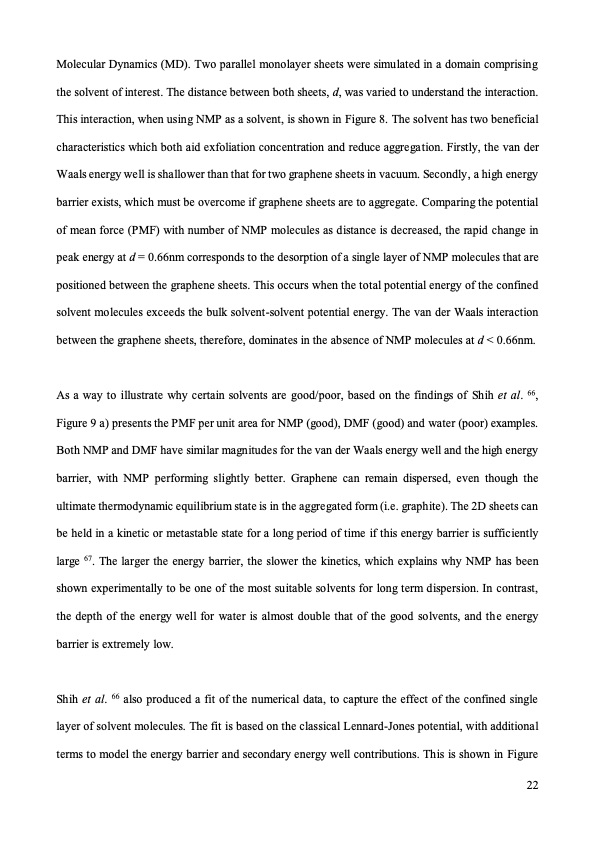PDF Publication Title:
Text from PDF Page: 022
Molecular Dynamics (MD). Two parallel monolayer sheets were simulated in a domain comprising the solvent of interest. The distance between both sheets, d, was varied to understand the interaction. This interaction, when using NMP as a solvent, is shown in Figure 8. The solvent has two beneficial characteristics which both aid exfoliation concentration and reduce aggregation. Firstly, the van der Waals energy well is shallower than that for two graphene sheets in vacuum. Secondly, a high energy barrier exists, which must be overcome if graphene sheets are to aggregate. Comparing the potential of mean force (PMF) with number of NMP molecules as distance is decreased, the rapid change in peak energy at d = 0.66nm corresponds to the desorption of a single layer of NMP molecules that are positioned between the graphene sheets. This occurs when the total potential energy of the confined solvent molecules exceeds the bulk solvent-solvent potential energy. The van der Waals interaction between the graphene sheets, therefore, dominates in the absence of NMP molecules at d < 0.66nm. As a way to illustrate why certain solvents are good/poor, based on the findings of Shih et al. 66, Figure 9 a) presents the PMF per unit area for NMP (good), DMF (good) and water (poor) examples. Both NMP and DMF have similar magnitudes for the van der Waals energy well and the high energy barrier, with NMP performing slightly better. Graphene can remain dispersed, even though the ultimate thermodynamic equilibrium state is in the aggregated form (i.e. graphite). The 2D sheets can be held in a kinetic or metastable state for a long period of time if this energy barrier is sufficiently large 67. The larger the energy barrier, the slower the kinetics, which explains why NMP has been shown experimentally to be one of the most suitable solvents for long term dispersion. In contrast, the depth of the energy well for water is almost double that of the good solvents, and the energy barrier is extremely low. Shih et al. 66 also produced a fit of the numerical data, to capture the effect of the confined single layer of solvent molecules. The fit is based on the classical Lennard-Jones potential, with additional terms to model the energy barrier and secondary energy well contributions. This is shown in Figure 22PDF Image | graphene production via nonoxidizing liquid exfoliation

PDF Search Title:
graphene production via nonoxidizing liquid exfoliationOriginal File Name Searched:
Graphene-R2-review.pdfDIY PDF Search: Google It | Yahoo | Bing
Salgenx Redox Flow Battery Technology: Power up your energy storage game with Salgenx Salt Water Battery. With its advanced technology, the flow battery provides reliable, scalable, and sustainable energy storage for utility-scale projects. Upgrade to a Salgenx flow battery today and take control of your energy future.
CONTACT TEL: 608-238-6001 Email: greg@infinityturbine.com (Standard Web Page)